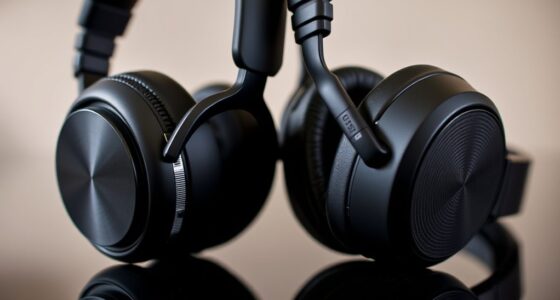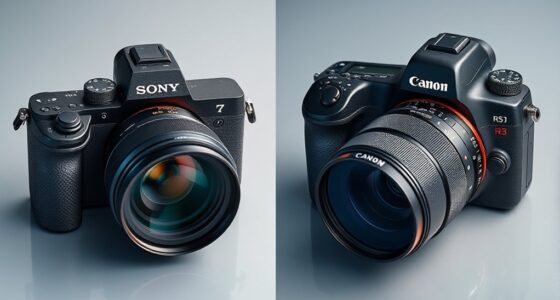If you’re choosing between the GoPro Hero13 and Insta360 Ace Pro, consider your filming needs. The Hero13 is compact, durable, and offers excellent stabilization with 5.3K video, ideal for extreme activities. The Ace Pro has a larger sensor, better low-light performance, and higher resolution options like 8K, making it perfect for cinematic projects. Both are feature-rich, but your priorities may spot the difference. Keep going to discover which camera aligns best with your style.
Key Takeaways
- The Insta360 Ace Pro 2 offers a larger 1/1.3″ sensor for superior low-light performance and higher resolution (8K vs. 5.3K in Hero13).
- GoPro Hero13 is more compact, lightweight, and rugged, ideal for extreme activities and underwater use up to 10m.
- The Hero13 features a physical button interface with voice control, while the Ace Pro provides a touchscreen and gesture controls for easier operation.
- Insta360’s Ace Pro 2 emphasizes cinematic quality, HDR, and AI editing tools, whereas Hero13 focuses on durability, stabilization, and extensive accessories.
- Both are premium-priced, but GoPro offers a more established ecosystem, while Insta360 excels in resolution and innovative AI-driven features.
Sensor Size and Image Quality

When it comes to sensor size and image quality, the Insta360 Ace Pro 2 clearly has an advantage with its larger 1/1.3″ sensor, which allows it to capture more light and detail. This bigger sensor enhances low-light performance and elevates overall image clarity. The Ace Pro 2’s f2.6 Leica lens further boosts sharpness, giving you crisp, high-quality images. While it shoots in 8K resolution, its larger sensor ensures better detail retention compared to devices with smaller sensors. Additionally, sensor size plays a crucial role in overall image sharpness and dynamic range, making it a key factor in choosing an action camera. A larger sensor also contributes to better bokeh and background blur, enhancing the cinematic quality of shots. This results in more professional-looking footage, especially in varied lighting conditions. Furthermore, the larger sensor significantly impacts noise reduction in low-light environments, providing cleaner images. Although the GoPro Hero 13’s sensor size isn’t specified, its advanced processing and 10-bit color depth help deliver vibrant, accurate colors. Still, the larger sensor on the Ace Pro 2 fundamentally improves image quality, especially in challenging lighting conditions. Moreover, sensor size impacts the depth of field, which can significantly affect the artistic quality of your footage.
Video Capabilities and Color Profiles
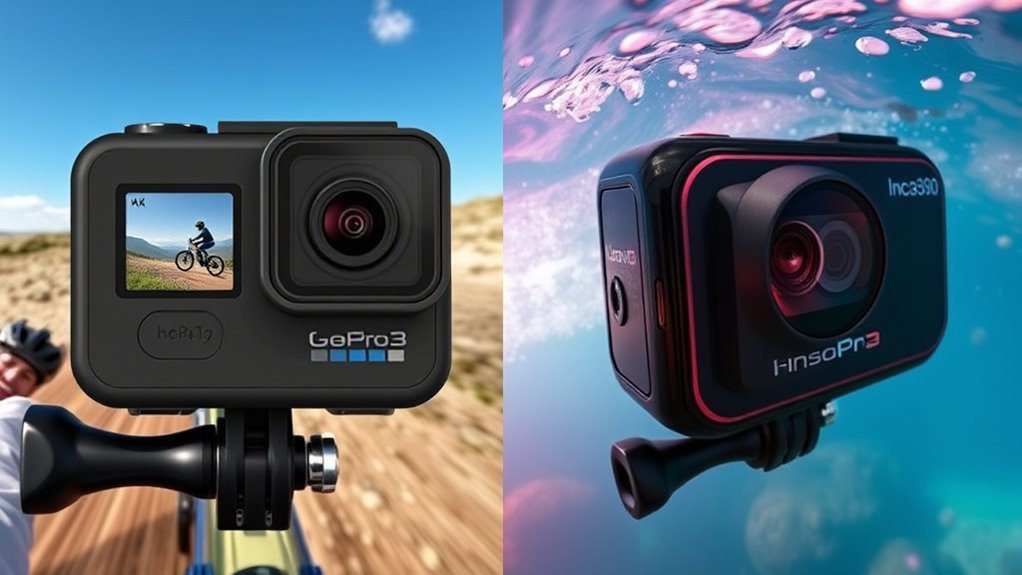
Both the GoPro Hero13 and Insta360 Ace Pro pack impressive video capabilities, but they prioritize different aspects of performance. The Hero13 supports up to 5.3K at 60fps and can shoot slow-motion at 240fps in 2.7K, with HDR at 5.3K 30fps. In contrast, the Ace Pro offers higher resolution at 8K but caps at 30fps, and supports 4K HDR at 60fps, providing smoother HDR footage. The Hero13 features 10-bit color for richer gradation, while the Ace Pro uses 8-bit but offers multiple in-camera color profiles for customization. The Ace Pro excels in low-light scenarios with better color handling, thanks to its larger sensor and night mode. Additionally, video quality plays a crucial role in capturing immersive footage, helping users decide on the best device for their specific needs. Overall, Hero13 emphasizes color accuracy and high frame rates, whereas Ace Pro focuses on resolution and HDR flexibility. When choosing between them, considering regional resources like local repair services and user communities can also influence your decision. Moreover, understanding the color profiles available on each device can help optimize footage for different environments and editing styles.
Build, Size, and Durability
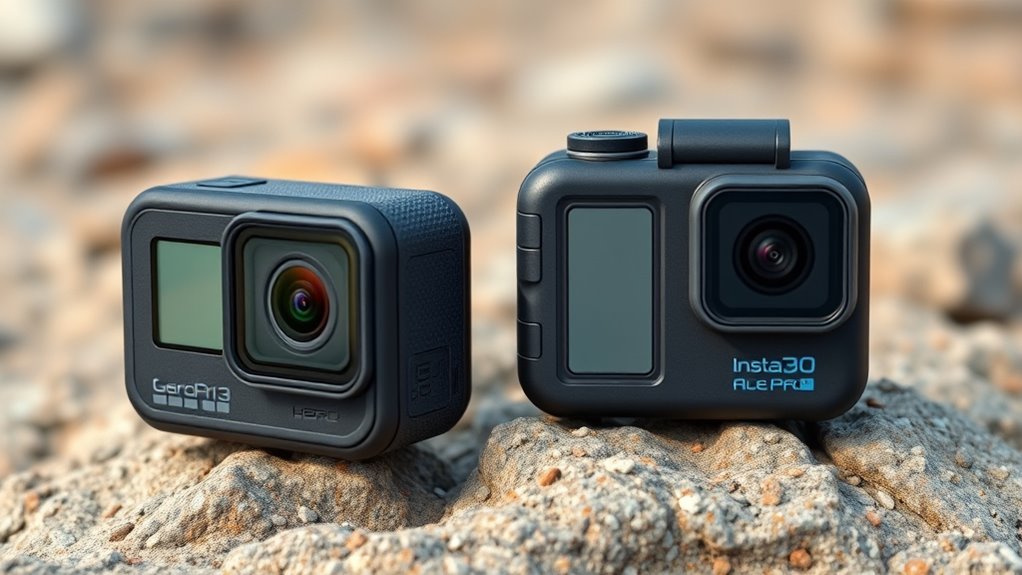
You’ll notice that both cameras are built with tough materials, designed to withstand outdoor adventures. The GoPro Hero 13 is more compact and lightweight, making it easier to carry around, while the Insta360 Ace Pro offers a slightly larger form factor with a bigger display. When it comes to waterproofing, both models are engineered for rugged use, but their mounting systems and overall durability may influence your choice depending on your activity. Additionally, their build quality ensures they can handle various environmental conditions, supporting prolonged outdoor use. A durable design is crucial for outdoor filming, especially in challenging weather or terrains. Moreover, considering environmental resistance is essential for selecting the right action cam for your specific needs.
Size and Portability
The GoPro Hero13 stands out for its compact and lightweight design, making it highly portable and easy to carry during active pursuits. Its smaller size and weight—about 157 grams—boost pocketability and quick handling. In contrast, the Insta360 Ace Pro 2 is larger and heavier at around 177 grams, which can impact portability. Consider these points: 1. Hero13’s smaller, more compact build enhances ease of transport. 2. Ace Pro 2’s larger size supports features like a bigger flip screen. 3. The lighter weight improves one-handed handling during motion. 4. The Ace Pro’s size may require extra protection or carrying solutions. Additionally, the durability of the action cameras can influence their suitability for rugged activities, especially when considering build quality and materials. A dog breed with a sturdy build and durable coat, like a Golden Retriever or a Doxie-Poodle Mix, exemplifies the importance of product durability in a pet’s active lifestyle, which can also be a consideration for action camera selection in tough environments.
Material and Construction
The material and construction of the GoPro Hero13 and Insta360 Ace Pro 2 directly influence their durability and handling in rugged environments. Both use high-quality materials, giving them a solid feel, though the Insta360 is slightly heavier at 177 grams, indicating denser or additional materials. The GoPro’s compact design may enhance impact resistance, while the Insta360’s bigger size could provide more internal shock absorption. Both cameras feature reinforced external casings designed to withstand impacts and daily wear. They incorporate quick-release magnetic mounts for easy attachment, with GoPro offering more versatile mounting options, including quarter-20 holes and folding fingers. Overall, their robust build and durable materials make them well-suited for action-packed adventures.
Waterproof Capabilities
When comparing the waterproof capabilities of the GoPro Hero13 and Insta360 Ace Pro, their build, size, and durability play crucial roles in how well they perform underwater. The HERO13 is rated for depths up to 10 meters without extra housing, thanks to its rugged design and water-repelling cover glass that keeps the lens clear. In contrast, the Ace Pro’s waterproof rating isn’t explicitly stated, so you might need additional protection for submerged use. Here’s a quick overview:
- HERO13’s built-in waterproofing up to 10 meters without a case
- Compact size of HERO13 enhances waterproof usability
- Larger, bulkier design of Ace Pro may require extra casing
- Both cameras are rugged, but HERO13’s removable cover boosts water resistance
These features ensure the HERO13 is more straightforward for underwater adventures.
User Interface and Control Features
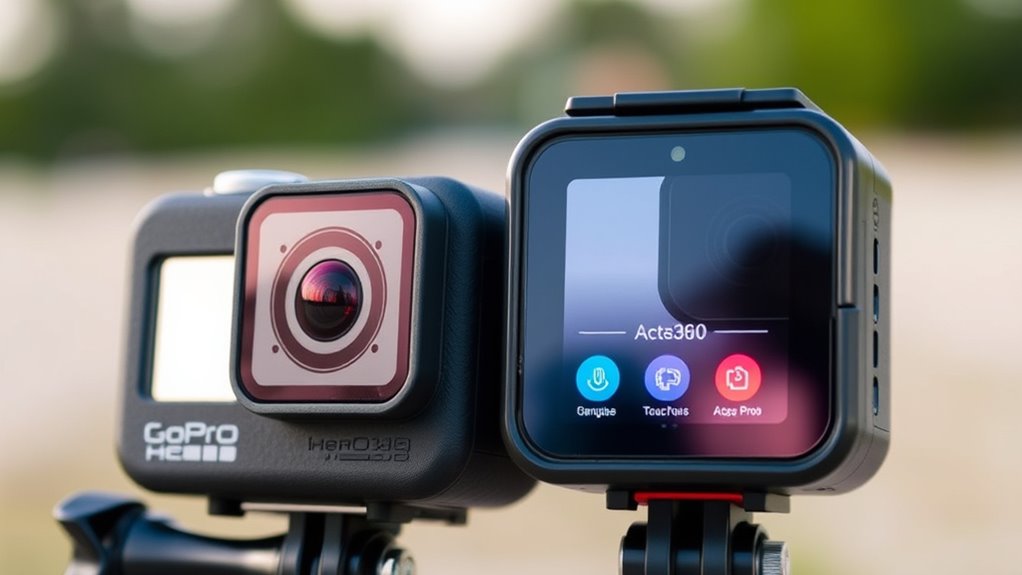
User interface and control features substantially influence how easily you can operate each camera, especially in dynamic shooting situations. The Insta360 Ace Pro’s tilting touchscreen offers flexible viewing angles and intuitive control, making framing and adjustments straightforward. Its touch interface allows quick access to settings and creative options, speeding up your workflow. In contrast, the GoPro Hero 13 Black has a full-color screen that isn’t touch-enabled, relying on physical buttons and voice commands for operation. While buttons are durable and easy to use during extreme activities, navigation may feel less intuitive. Both cameras support companion apps for remote control and editing—GoPro’s Quik app and Insta360’s feature-rich app—enhancing user interaction. Overall, the Ace Pro’s touchscreen and gesture controls provide a more user-friendly experience for quick adjustments and creative control. Additionally, user interface design plays a crucial role in the overall usability of high-quality devices, emphasizing the importance of intuitive controls in high-tech device experiences. Incorporating sound design principles, such as clear audio feedback and minimal latency, can further improve the usability of camera interfaces, especially in fast-paced environments. Furthermore, ergonomic design ensures that controls are comfortable and accessible during prolonged use, improving the overall user experience. Incorporating cultural and regional considerations in interface design can also help cater to diverse user preferences worldwide.
Audio Performance and Connectivity

Both the GoPro Hero 13 and Insta360 Ace Pro 2 deliver solid audio performance, but their connectivity options and microphone capabilities set them apart. Here’s what you need to know:
- The Hero 13 records well in moderate wind but struggles in very windy conditions, despite wind noise reduction. Audio limitations can be a concern in such environments, emphasizing the importance of external microphones. Additionally, advancements in audio processing technology are helping to mitigate some of these issues. The integration of external microphone support enhances versatility for different shooting scenarios.
- The Ace Pro 2 supports the Mic Air wireless microphone system, providing clearer, isolated audio away from the camera.
- Both feature Wi-Fi and Bluetooth for quick pairing, with the Hero 13 using USB-C for data transfer and external mic connections.
- The Ace Pro 2’s external Mic Air considerably enhances vocal clarity, outperforming internal mics in noisy environments.
- To maximize audio quality, especially in outdoor and high-wind scenarios, external mics are recommended, aligning with advancements in AI-powered audio analytics.
Pricing and Market Position
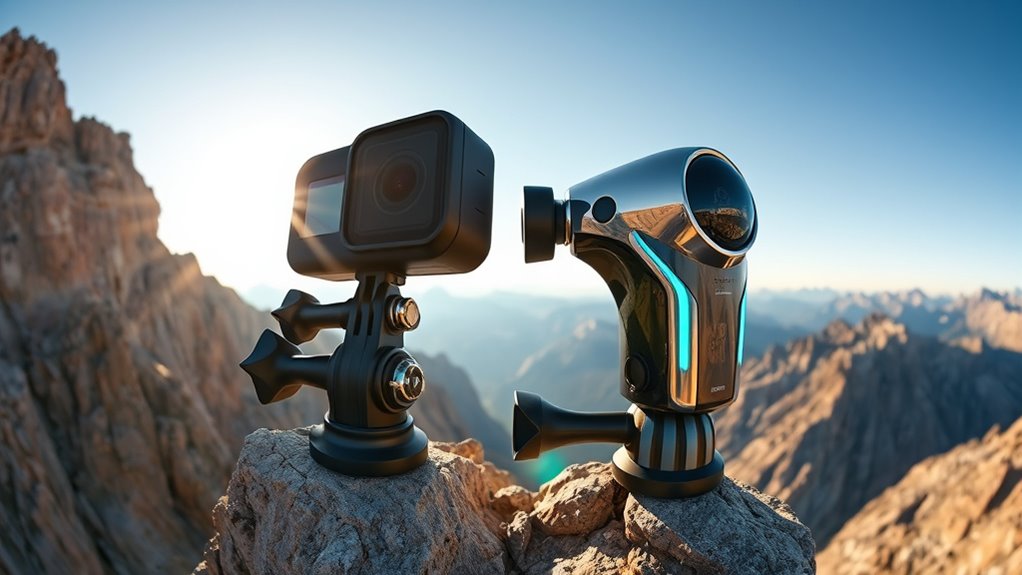
Both the GoPro Hero13 and Insta360 Ace Pro 2 are priced around $399.99, positioning them as premium options, but their ecosystems and brand reputations attract different user segments. Understanding how these factors influence your choice can help you decide which camera offers better value for your needs. For those seeking a stylish and trendy aesthetic, preppy dog names might inspire your personalization choices, reflecting a refined and fashionable sensibility preppy dog names.
Similar Price Range
The GoPro Hero 13 Black and Insta360 Ace Pro 2 are priced very similarly, positioning themselves as premium action cameras around the $400 mark. You’ll notice their prices are almost identical in the US and UK, both at $399.99 and £389-399, respectively. In Australia, the Insta360 is slightly pricier at AU$689.99 compared to the Hero 13’s AU$649.95. Consider these points:
- Both models target high-end consumers with near-identical MSRP.
- They compete directly in the premium segment, focusing on advanced features.
- Regional variations slightly affect the Insta360’s price, especially in Australia.
- Their pricing aligns with their market positioning as flagship action cameras.
- The Forsale 100 indicates strong market demand and competitive positioning for these models. Additionally, their market positioning emphasizes their appeal to consumers seeking top-tier performance without significant price differences.
This similarity underscores their rivalry for users seeking top-tier performance without significant price differences.
Ecosystem and Brand Value
GoPro’s established reputation as a pioneer in the action camera market gives its products a significant edge in brand trust and ecosystem maturity. Its extensive accessory lineup, including mounts, batteries, and media mods, offers versatility and reliability. Insta360, while newer, excels with innovative features like AI editing tools and 8K video, appealing to tech-savvy creators. Both brands price their cameras around $399.99, but GoPro often provides discounts, making it more accessible. The market perceives GoPro as rugged and dependable, while Insta360 is seen as cutting-edge and feature-rich. Their ecosystems reflect these perceptions, with GoPro’s broad accessory compatibility and Insta360’s seamless app integration. The table below summarizes their ecosystem strengths:
| Feature | GoPro | Insta360 | Market Impact |
|---|---|---|---|
| Accessories | Extensive, third-party supported | Magnetic mounts, quick swaps | Ecosystem maturity and trust |
| Software | Firmware updates, expansion | AI editing, mobile app | User experience and creativity |
| Compatibility | Wide range of mounts, mods | Seamless app integration | User convenience |
| Innovation Focus | Rugged durability | 8K, AI features | Market differentiation |
| Brand Perception | Rugged, reliable | Innovative, feature-rich | Consumer confidence |
A key factor in the ecosystem strength is the compatibility of accessories and software, which enhances user experience and reinforces brand loyalty.
Target User Segments
With a price point of around $399.99, the GoPro Hero 13 Black and Insta360 Ace Pro 2 are positioned as premium mid-range action cameras aimed at different user groups.
- If you’re loyal to GoPro’s ecosystem, you’ll value reliable 5.3K video, HyperSmooth stabilization, and easy mounting options, ideal for athletes and outdoor adventurers.
- For tech-savvy creators, Insta360’s AI-powered editing, 8K resolution, and advanced post-production attract those focused on social media and professional content.
- Budget-conscious buyers may consider accessory bundles and ecosystem compatibility, seeking the best value within this tier.
- Both brands target users who want flagship features without the ultra-premium price, pushing innovation in hardware, AI, and software.
Frequently Asked Questions
How Do These Cameras Perform in Extreme Weather Conditions?
You’ll find that the GoPro HERO13 Black performs well in extreme weather, thanks to its broad temperature range, durable design, and waterproof capabilities up to 33 feet. Its Enduro battery lasts longer in cold conditions, and HyperSmooth stabilization keeps footage steady. The Insta360 Ace Pro is rugged as well, but specific details on its weather performance are limited. Overall, both are built for tough environments, with GoPro offering more proven waterproof and temperature resilience.
Can the Cameras Stream Live Footage Directly to Social Media?
Imagine your footage soaring directly into your audience’s feed—that’s what live streaming offers. With the GoPro Hero13, you can stream live directly to platforms like Twitch, YouTube, and Facebook, thanks to native support and RTMP compatibility. You simply connect via the GoPro app, set up your stream, and go live. Meanwhile, the Insta360 Ace Pro doesn’t support native live streaming, often requiring extra software, so your options are more limited.
What Are the Options for Expanding Storage Beyond Internal Memory?
You can expand your camera’s storage by using MicroSD cards. Both cameras support cards up to 1TB, with recommended brands like Samsung Evo Select or SanDisk Extreme, and minimum V30 speed class for reliable recording. Regularly offload footage to your PC or cloud storage to free up space and prevent card wear. Always verify compatibility and choose high-quality cards to guarantee smooth recording and data safety during your adventures.
How Effective Are the Stabilization Features in High-Motion Activities?
You want to know how well these cameras handle stabilization during fast, high-motion activities. The GoPro Hero 13 offers HyperSmooth with boost mode, delivering smoother footage even during intense movements like running through trees. The Insta360 Ace Pro also stabilizes well but slightly less effectively in rapid actions. Overall, the GoPro’s advanced stabilization algorithms make it more reliable for capturing smooth footage during extreme sports or dynamic activities.
Do Both Cameras Support External Microphones for Enhanced Audio Recording?
You want to know if both cameras support external microphones for better audio. The GoPro Hero13 supports both wired and wireless mics, pairing easily via Bluetooth and using adapters like the Media Mod for wired options. The Insta360 Ace Pro mainly works with its proprietary Mic Air, which offers excellent wireless audio quality. While both improve sound, the GoPro offers more flexibility with third-party and wired mics, making it more versatile.
Conclusion
So, whether you prefer the sleek, rugged hero of GoPro or the all-in-one wizardry of Insta360, one thing’s clear: both are here to make your action shots look like Hollywood films—if only your friends cared as much as your camera does. Pick your poison, because in the end, they’re both just fancy gadgets vying for your adrenaline-filled dollar, proving once again that tech’s biggest thrill is convincing you it’s worth the price of a small island.





